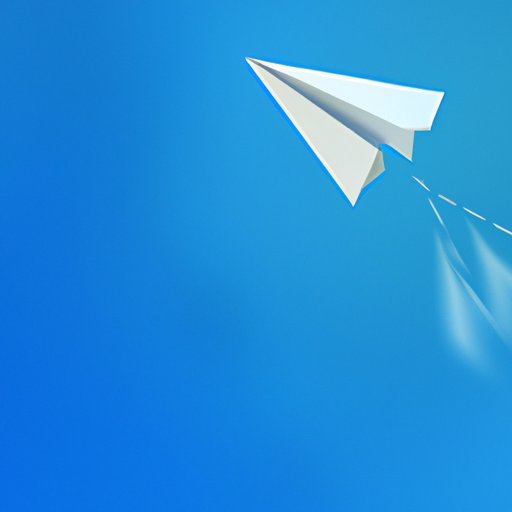I. Introduction
Paper airplanes are a classic childhood craft that many will never forget. However, the frustration of making a paper airplane that either nosedives right away or never went beyond a few feet in flight can be quite frustrating. Never to worry, this article will teach you how to make paper airplanes that fly far so that you can impress your friends and family with your newfound skills.
II. Start With the Basics
The basic design for a paper airplane includes folding the paper in half vertically, then unfolding it, folding the top two corners to the center crease, and finally folding the newly made wings down so they meet at the center crease. This makes a typical paper airplane design that can fly straight but may not fly that far.
To make a paper airplane that flies farther, try adding some drag to the tail area by making a small fold at the back of each wing. This drag will help stabilize the airplane’s flight path and give it more lift when launched.
Another simple modification to make to a basic paper airplane is to create a wing fold in each wing that results in creating an angle in the wings’ trailing edge. To make this modification, fold the wing down to the body’s corner edge and make a crease from the top to bottom. Unfold the crease, then push the trailing edge of the wing back so that it aligns with the crease made before folding down. Refold the wing along the crease, and your paper airplane will now have a forward-swept wing with an upward angle that will make it easier to fly and stay in the air longer.
III. Experiment With Paper Types and Weights
The type and weight of the paper you use can have a significant impact on the flight of your paper airplane. Generally, lightweight and thin paper works best because it is easier to fold and weighs less than thicker paper. If you use heavy paper, the plane is likely to nose dive quickly.
If you’re struggling to get your paper airplane to fly as far as you’d like, try experimenting with different paper types. Some types of paper that work well for making paper airplanes include printer paper, origami paper, and lightweight construction paper. These types of paper are thin, flexible, and easy to work with, making them perfect for folding.
IV. Proper Folding Techniques
Folding paper correctly is key to creating a paper airplane that can fly far. To get started, make sure that you have a flat, smooth surface to work on and that you follow the fold lines as closely as possible.
Using a bone folder or a credit card can help create sharp creases, which will help your paper airplane glide across farther in flight. The smoother your folds, the more consistent the shape of your paper airplane, and the better it will fly.
V. Adjusting the Plane’s Design for Maximum Distance
If you want to make a paper airplane that can fly as far as possible, it’s essential to adjust the design to maximize its potential. Here are a few design modifications that you can experiment with:
- Bigger wings: Larger wings provide more lift, which will help your paper airplane stay in the air for more extended periods.
- Narrower body: A narrow body makes the plane go through the air smoothly, which decreases drag and improves its aerodynamics.
- Curved wings: Curved wings increase lift and decrease drag, which means that your paper airplane will stay in the air longer and travel farther.
VI. Environmental Factors
The environment in which you’re flying your paper airplane will also impact how far it will fly. Wind, temperature, and humidity all play a role in how far your paper airplane will travel.
When flying your paper airplane, try to launch it in areas with little to no wind. If you must launch it in spots with wind, consider launching it from a higher surface, like a balcony or rooftop, where the wind is less turbulent.
VII. Launch Techniques
The technique you use to launch your paper airplane will also impact how far it will fly. Here are a few tips:
- Hold the airplane at the midpoint of its body or slightly towards the back, with your thumb on one wing and fingers on the other.
- Hold the airplane at eye level, or higher, to ensure a level launch.
- Put a slight upward tilt to your launch and aim it towards the sky.
- Ensure a clean release of the airplane and give it a strong, focused throw.
VIII. Fun Challenges and Games
Now that you know how to make a paper airplane that flies far let’s put your skills to the test. Here are some fun challenges you can try:
- Distance Challenge: See who can throw their airplane the farthest. Mark the spot where it lands and measure the distance each time.
- Pair Distance and Accuracy Challenge: Choose a target location and see who can get their airplane closest to it while still throwing the farthest distance.
- Flight Endurance Challenge: The child whose plane stays in the air for the longest duration wins.
- Obstacle Course Challenge: Create a small obstacle course and each child must fly their airplane through it quickly for a chance to win.
IX. Conclusion
Learning how to make a paper airplane that flies far isn’t as challenging as it may seem initially. While there are many modifications and adjustments that you can make to boost your plane’s flying quality, you can start with the basics, experiment with different paper types, and follow the proper folding techniques. Also, consider the environment you’re flying in, launch techniques, and have fun by engaging in different challenges and games.
So, grab some paper and let’s get started. We hope you enjoyed our guide on making a paper airplane that flies far.
